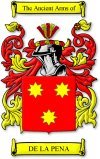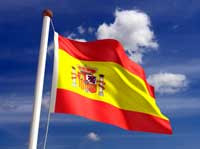
According to certain traditions St Peter took the Cup of the Last
 Supper from the Cenacle of Jerusalem and sent it to Rome. Ancient historians, such as Siuri, bishop of Sales, are championning this thesis. In Rome this was the papal Chalice, beginning with St Peter up to Sixtus II. In the beginning of Christianity, Popes were celebrating Mass only with this Chalice. These facts appear to conform with a notably valuable document: the Mass Canon (the ancient Papal Canon). According to it, Popes when were taking this 'Santo Caliz' for the consecration of wine were saying in Latin:
Supper from the Cenacle of Jerusalem and sent it to Rome. Ancient historians, such as Siuri, bishop of Sales, are championning this thesis. In Rome this was the papal Chalice, beginning with St Peter up to Sixtus II. In the beginning of Christianity, Popes were celebrating Mass only with this Chalice. These facts appear to conform with a notably valuable document: the Mass Canon (the ancient Papal Canon). According to it, Popes when were taking this 'Santo Caliz' for the consecration of wine were saying in Latin:<
St Peter as eyewitness and the rest of Popes knew that it was the Holy Cup where the Lord had consecrated the wine at the Last Supper. Today when a priest, bishop or pope celebrates Mass with another chalice says the words "taking the cup...", such as it is written in Gospels (Mt 26:27), only with the Santo Caliz they can say "taking this cup...".
The Holy Grail
St Lawrence distributing the papal goods (Chapel Nicolina)The Vatican
St Peter's successor was Linus, then Anacletus, Clementis, Evariste, Alexander, Sistus I, etc.In year 258, being pope Sistus II, the Roman emperor Valerianus signed an edict to appropiate the whole Christian possessions. Sistus II gave the papal goods to his deacon, the Spanish St Lawrence, with the goal that were distributed amongst beggars. So he did it, except the Santo Caliz. Before that both Sistus II and St Lawrence were killed, the daecon gave the Grail to a Spanish soldier who transferred it to Huesca (Spain). There was a painting fresco in the St Lawrence's Basilica (Rome) where was recorded the fact of this saint giving the Chalice (a two-handled chalice) to a Spanish soldier, but this painting and others with Grail images were destroyed in the bombardment of Rome by the Allies, July 1943. Mr Waol, chancellor of this Basilica during 30 years, describes this picture with the characteristic two-handled Grail in his book Rampilgerl.
St Juan de la PeñaMonasterio Bajo
In 553, Vicentius, bishop of Huesca, placed the Holy Chalice at the new temple in this town, where it was for 158 years. In 711, Muslims invaded Spain, from the south they began to extend toward north. The Huesca bishop, Acisclo, his nephews, Orosia and Cornelio, and a group of christian supporters taking the Grail ran away to Southern Pyrenees. They hid the Chalice inside the wall of Chapel of S. Pedro de Siresa, and built a star on the ground with one of the arms pointing its exact position. Later, bishop Acisclo and his nephews were killed by Moor Muza' troops, however the Holy Grail remained safe in 'S. Pedro de Siresa' for a century. Then the Chalice was moved to Cathedral of Jaca, and finally, in 1063, it was transferred to St. Juan de la Peña Monastery, a incredible building placed inside of a cave in an inaccessible mountainside. Knights Templar were guarding this Grail.
Four centuries later, in 1399, the Santo Caliz stood still in St Juan de la Peña (see map of Holy Grail), then the King of Aragon, Martin V 'the Human', determined to move it at the chapel of the Royal Palace in Zaragoza. To silence the claims of Monasterio Bajo monks he made a gold replica of this Grail for the Monastery, which centuries later was destroyed by the monastery fire. Upon the king's death, in 1410, the Santo Caliz was found in the inventory of his properties in Barcelona. The successor to throne was Fernando de Antequera who died four years later. Then the new successor was Alfonso V 'the Magnanimus', King of Valencia, Aragon, Majorca, Napoles and Sicily. In 1424, Alfonso V brought the Holy Chalice at the Palacio Real in Valencia. In 1437, Alfonso's brother, Don Juan, King of Navarre placed the Grail at the Valencia Cathedral where today is present. From this Cathedral it was taken out only twice: during the Independence war (1809-1813) it moved to Alicante, Ibiza and Palma of Majorca; and at the National Uprising (1936-1939) it was hidde at private homes in Carlet and Valencia.
In 1982, H.H. Pope John Paul II came to Valencia, when he celebrated Mass with the Santo Caliz, 1724 years later, a Pope was able to celebrate the Mass with the Holy Grail.
Pope John Paul II celebrating Mass with the Holy Grail


No comments:
Post a Comment